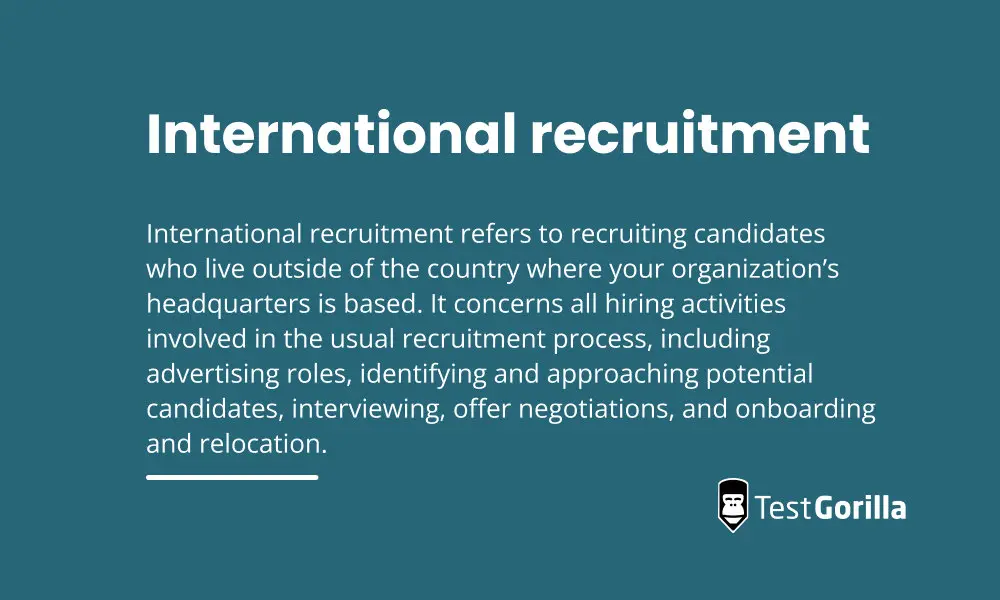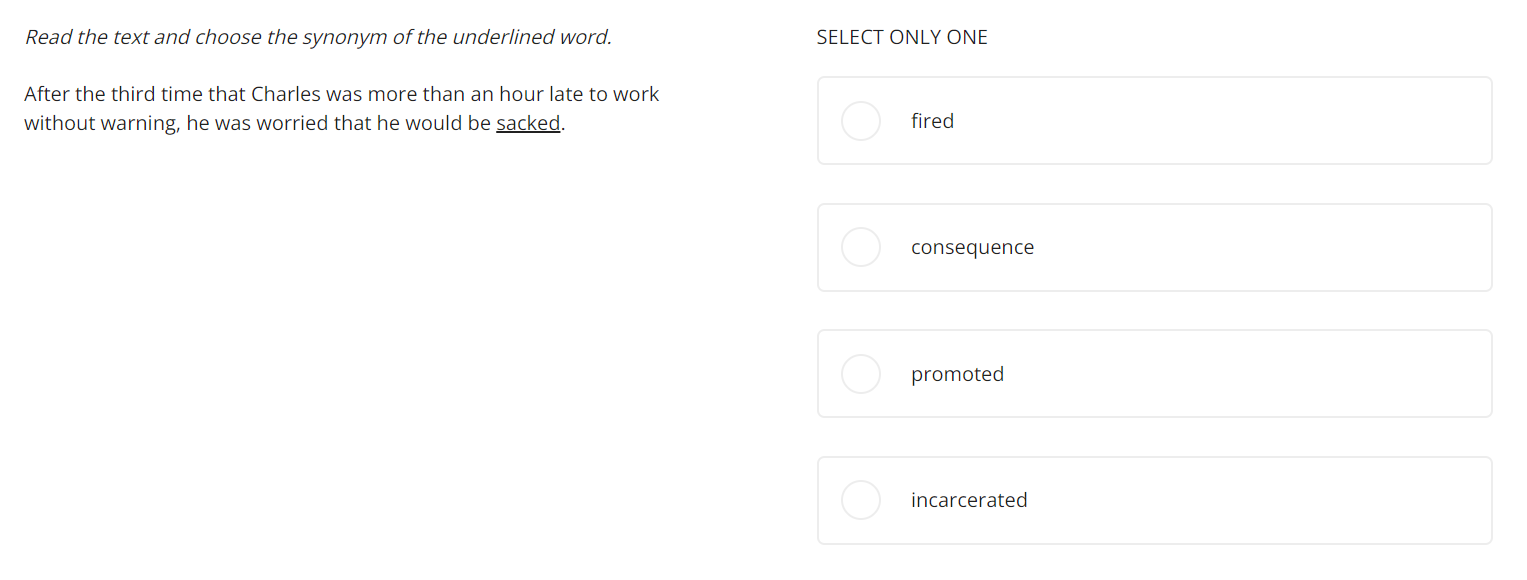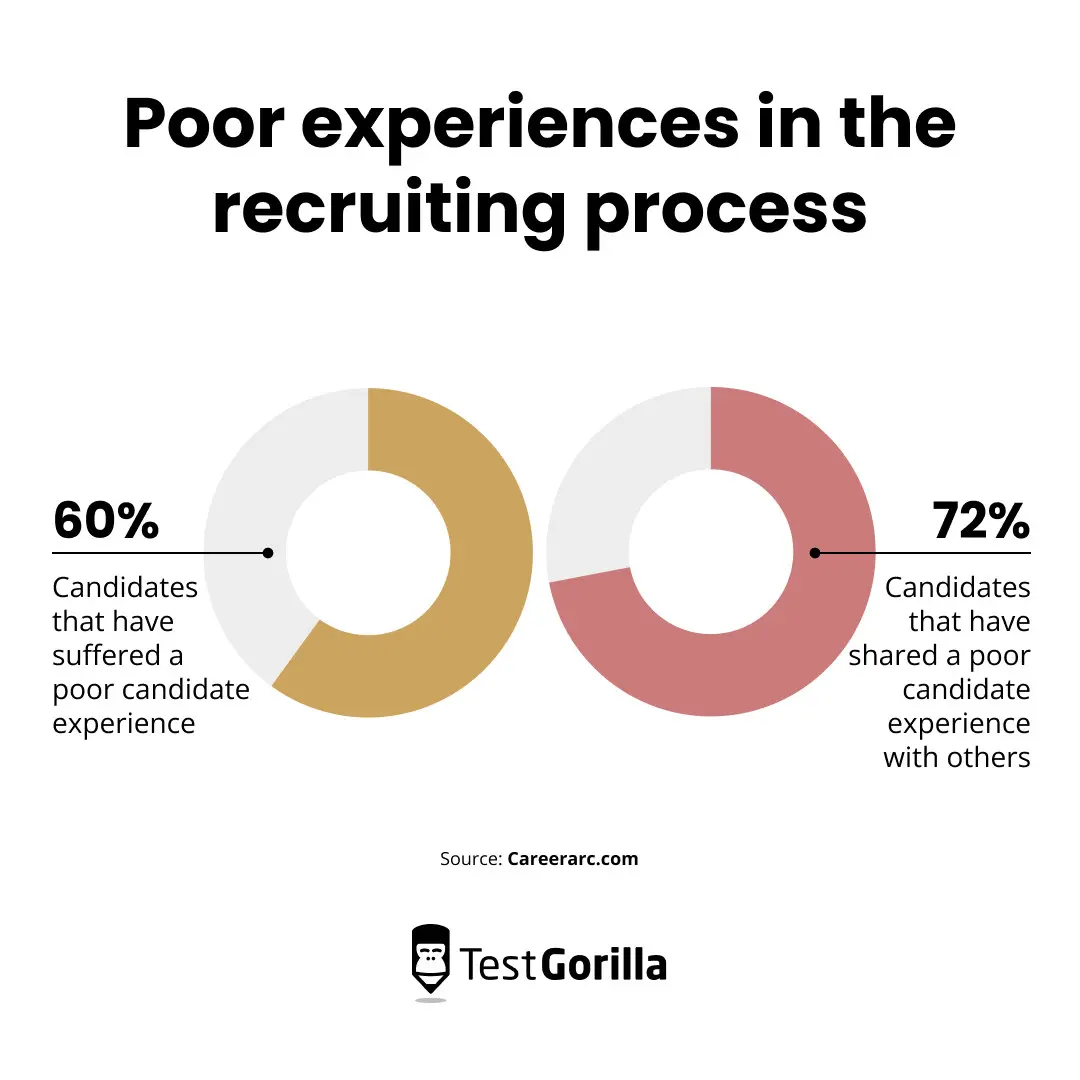Recruiting internationally: How to leverage this talent acquisition trend and hire international employees
Recruiting internationally is more accessible than it’s ever been. The widespread adoption of remote working and hiring tools means many organizations are accepting international applicants.
Nowadays, it’s easier to hire when expanding abroad.
Out of 100 global businesses already operating in more than one country, 97% were planning on expanding into new markets in 2023.
The most attractive places were:
Continental Europe (72%)
The United Kingdom (70%)
North America (58%)
Asia Pacific (58%)
Latin America (56%)
The Middle East (54%)[1]
However, there are plenty of challenges that come with global recruitment, such as assessing language capabilities and accommodating the local market.
This blog discusses the difficulties of international recruitment and the best practices to overcome them so you can reap the benefits of this stellar talent acquisition trend.
If you’d like, go ahead and skip straight to the tips on international recruiting.
Table of contents
- What is international recruiting?
- Why is international recruitment important?
- The benefits of hiring international employees
- 9 best practices for leveraging global recruitment to acquire top talent
- Recruiting internationally: 3 examples of companies succeeding with this talent acquisition trend
- Use talent assessments when recruiting internationally to reduce bias and gauge skills
What is international recruiting?
International recruitment refers to recruiting candidates who live outside of the country where your company is based.
It involves all hiring activities involved in the normal recruitment process, including:
Advertising roles
Identifying and approaching potential candidates
Interviewing
Onboarding and relocation
International recruitment is facilitated by many talent acquisition strategies, such as social media recruiting and leveraging remote job fairs.
This leads us to an important point: Is international recruiting always remote?
Some international recruiting activities are examples of remote recruiting, but not all of them fall under this category.
This is because remote recruiting refers specifically to hiring initiatives in which you don’t meet candidates in-person at any point during the hiring process. This is usually done for remote roles.
Hiring international employees may use both remote and in-person techniques because it may lead to relocation or setting up a new office in a new country.
Why is international recruitment important?
International recruiting has gained massive traction thanks to the rise of technology.
Technology enables remote work and hiring and facilitates physical expansion through easy access to tools that assess language, expedite payment, and provide access to translators.
Hiring international employees is easier than it’s ever been, which is good because it’s an important strategy for employers:
Expansion into new markets and territory: Opens your company to a new market and new audience, enabling you to increase your customer base and busy seasons.
Operate in new time zones: Different countries mean new time zones, which increases your hours of operation. This is beneficial for many reasons, and it’s excellent for customer support.
Nurture great diversity: Hiring international employees leads to greater diversity, which increases creative thought and innovation.
Reach outside your local market: Your region may not have the skills you need. Reaching out internationally enables you to find global talent you couldn't before and secure niche skills.
Let’s expand on that last point.
Some roles are hard to fill domestically due to skills shortages in your industry or region. In a candidate’s market, there may be stiff competition in your local area.
One study by ManpowerGroup found that 77% of organizations worldwide reported talent shortages in 2023, the highest in 16 years.
But with global recruiting, a wider pool of candidates gets the chance to explore international careers or gig opportunities with you. This empowers them to learn new things and find companies they truly align with.
Global hiring also helps your current staff. It opens their perspectives and boosts their innovation when they work with international colleagues.
The challenges of international recruiting
Recruiting internationally is easier than it’s ever been, but it isn’t without its difficulties.
Here are the top challenges with international recruitment.
Language barriers
The hiring process relies on communication between candidates and hiring managers, so if you accept applications from candidates who don’t speak English as a first language, you might run into problems.
This includes resume translation errors, misunderstandings during interviews, and miscommunications about qualifications and skills.
In many cases, you might not even realize that language barriers exist between you and your candidates until you hit an issue during the interview.
Unfortunately, traditional hiring methods don’t have solid ways to assess language proficiency. Most hiring managers have to rely on what the candidate wrote on their resume, which is easy to misjudge.
Lack of familiarity with candidates’ backgrounds
It may be difficult to understand the background and education of a candidate when hiring an international employee.
One study found more than 90% of employers use recruitment management systems to filter or rank potential candidates. These systems leverage college degrees as a common proxy for attributes, including skills, work ethic, and the ability to work independently.
It’s easy enough to create a shortlist from this information when comparing candidates who studied in your home country. However, this approach becomes much harder when you’re comparing international candidates for whom you lack this context.
Traditional hiring doesn’t give you many options, either. Because you don’t have an objective way to measure candidates’ skills, you need to rely on a candidate’s background and certifications.
Cultural differences
Recruiters comparing international candidates have to navigate cultural differences when hiring.
For example, studies show that different cultures have different expectations when it comes to work environments.
Organizations in Africa prioritize agility and flexibility, but companies in Eastern Europe and the Middle East value stability and preparedness.
This can affect many things, like how you advertise your roles in different markets and how you approach structuring a new international team.
Culture can affect a candidate’s expectations of the role, but cultural factors might also influence how your interviewers perceive the motivation of the candidate.
Using the example above, interviewees from the Middle East may have different perspectives on how to navigate change compared to interviewees from Africa.
Unconscious bias
This is possibly the most important challenge to handle: You need to work to reduce bias when comparing international candidates.
In traditional hiring, this could be impossible. Because the process generally leaves your hiring managers unsupported by data, they’re forced to lean unknowingly on their unconscious biases to help make decisions.
This issue can manifest at various points, such as screening resumes.
For example, one study found foreign candidates had much lower chances of receiving a positive response from employers than native candidates.
The study showed an ethnic preference in the responses, with European minorities more likely to receive a positive outcome than Middle Eastern and African candidates.
And bias doesn’t end at resumes – it can carry through to interviews.
For instance, an interviewer might be more likely to assume that a language barrier indicates incapability or that lack of eye contact indicates disrespect, even if direct eye contact is considered disrespectful in the candidate’s culture.
International recruiters need more support to make unbiased hiring decisions and eliminate situations in which stereotypes are their only means of comparing international candidates.
You can’t simply ignore these challenges; the immense benefits of recruiting internationally make them worth tackling.
The benefits of hiring international employees
International recruitment has impactful benefits for your company.
Whether you’re hiring remotely or physically expanding your business to a new area, hiring international employees brings fresh perspectives and great new talent to your organization.
Expand your talent pool
Your company can enjoy a much wider talent pool when you extend your reach overseas.
Reaching into brand-new countries means you have access to brand-new talent – and plenty of it.
For example, the American workforce totals 167 million people, a healthy pool to pull from. But let's say you expand and start hiring candidates from China. This country alone adds 733 million people to your talent pool.[2] [3]
This additional pool of candidates may also be more engaged and interested in your organization. Local recruiting means you’re accessing candidates in your direct area, so they have limited options for work.
International recruitment means that your candidates have access to thousands of opportunities and still choose yours.
Quickly and efficiently fill skills gaps
Recruiting internationally means you have easier access to specialists from all over the globe, including contingent workers in specialized fields.
This helps you fill essential skills gaps.
For example, America is facing a tech skills shortage, with many companies scrambling to fill essential positions.[4]
However, increasingly more talented Indian tech professionals have begun taking up freelance work on Upwork and Fiverr alongside their full-time jobs.[5]
But this benefit isn’t only for remote recruiters.
In-person international recruitment enables you to access professionals from a new market and area. Your local market might not have had the talent you needed, and these new candidates come into your company with unique backgrounds and perspectives.
Speaking of unique backgrounds…
Increase diversity and reap all the benefits that come with it
Global recruitment empowers you to increase diversity and boost productivity, creativity, and innovation.
Of course, you can only achieve this diversity by respecting unique perspectives and opinions. This means you can’t hire for culture fit.
We recommend hiring for culture add instead.
Comparing international candidates’ culture add enables you to maximize the benefits of international hiring. Having differing opinions and perspectives in your team increases diversity of thought.
In fact, Deloitte research shows diversity of thinking increases innovation by about 20%.[6]
We discuss culture add more later on in this blog.
Open your company to remote work models
International recruiting is a great opportunity to open your organization to remote work models and all the benefits associated with them.
Hiring remote employees gives you access to more candidates – not only international ones but also people who find traditional work difficult, such as disabled candidates and working parents.
And this perk improves satisfaction. One survey found that 65% of workers prefer 100% remote work. This alignment makes happier employees and increases the number of applicants.
Does your company already offer remote work?
You can still see increased benefits since recruiting internationally leverages your use and knowledge of remote processes.
For more insights, read our guide on flexibility in the workplace.
9 best practices for leveraging global recruitment to acquire top talent
International recruitment and selection can be tough, but our best practices help you maximize the benefits and overcome the challenges.
Here are our top strategies for recruiting internationally.
Strategies for recruiting internationally: A summary
Strategy | Description |
1. Assess candidates’ language proficiency with language tests | Confidently gauge language skills even when for languages you don’t speak |
2. Use talent assessments to stop relying on history and backgrounds | Evaluate a candidate on their skills and don’t let a lack of degrees hold you back |
3. Shift focus from culture fit to culture add | Increase diversity by hiring for culture add, a concept that doesn’t make people fill a rigid mold |
4. Take steps to reduce unconscious bias | Use methods like skills tests and unstructured interviews to reduce bias innate in the hiring process |
5. Optimize remote recruiting | Leverage remote recruiting practices with a host of tech that facilitates the process |
6. Widen your candidate sourcing with international job boards and social media | Widen your international talent pool Connect with workers over social media to find great passive talent |
7. Tailor your recruitment marketing campaign to different regions | Build a recruitment campaign that suits local tastes and attracts the right candidates |
8. Build an amazing candidate experience | Prioritize the candidate experience and improve your company reputation |
9. Create an international employer brand | Create an employer brand that helps you attract workers from across the world |
1. Assess candidates' language proficiency with language tests
Using talent assessment tests is the biggest recruitment tool in the skills-based hiring arsenal, and the first barrier it helps you overcome is language.
At TestGorilla, all of our tests can be administered in multiple languages. Even though you might view the results in English, your applicants can navigate the test with no barriers.
You can also test all candidates directly on their language proficiency. Here’s our English Proficiency test as an example:
This has many uses. For instance, you might test the candidate’s English fluency to assess whether they’ll have difficulties interviewing or communicating with the head office.
You can also test their fluency in the language of your target country to ensure they can communicate with clients.
Assessments get the job done – our State of Skills-Based Hiring report found mis-hires reduced in more than 90% of organizations after they switched to skills-based recruitment.
2. Use talent assessments to stop relying on history and backgrounds
Because you’re testing skills directly, you don’t need to rely on outdated, time-consuming methods like resumes and degree requirements to qualify candidates.
Measuring skills is a more effective tool than any of the information you get from a resume. A study at Google found that years of work experience only predicted job performance with 3% accuracy, and skills testing was almost 10 times as effective.[7]
In fact, much of the demand for skills-based hiring comes from employers realizing traditional hiring measures are simply broken.
It’s important to remember degrees are not guarantees of required skills, especially when you lack any context of international standards.
Requiring degrees also cuts you off from a huge pool of talented candidates known as STARS, or workers who are “Skilled Through Alternative Routes.”
Talent assessments are an inclusive hiring tool, enabling you to gauge candidates’ skills without any assumptions about their education and work history. This leads to more qualified candidates and a wider range of diversity.
3. Shift focus from culture fit to culture add
When comparing international candidates, many cultural challenges come down to “culture fit.” This evaluates whether the candidate would fit in with your current staff, replicating the attributes and traits you already have.
You might prioritize candidates from cultures more similar to your own or stick to domestic candidates despite finding amazing international candidates.
Not only does hiring for culture fit perpetuate bias, but it may also cause work silos and can lead to issues like workplace cliques and a lack of innovation.
All employers, especially those who hire internationally, should instead shift the focus from culture fit to culture add.
Instead of reproducing traits of your existing workforce in a new country, culture add ensures candidates share your organization’s underlying values while adding something unique.
This helps you respect different opinions and consider international perspectives, fostering a good company culture and building your international employer brand.
4. Take steps to reduce unconscious bias
As we’ve touched on in each of the above points, skills-based hiring limits opportunities for unconscious bias when comparing international candidates.
It does this at the screening stage by eliminating the need for resumes and replacing them with objective talent assessments. It also limits interviewer bias by providing a base of information to compare candidates’ proficiency.
And it’s not only skills testing that can help here.
Using structured interviews (a skills-based hiring method) can help reduce bias in hiring because it relies on a pre-written script. Interviewers then use this script to ask every candidate the same questions in the same order.
This makes comparison much easier; you’re comparing the answers to the same questions.
This type of interview is essential when many traditional “red flags” don’t exist cross-culturally. For example, people in America place a lot of importance on eye contact, but it's considered rude in Japan and South Korea.
The data proves skills-based hiring methods reduce bias – according to the State of Skills-Based Hiring 2022 report, 91.1% of companies saw an increase in diversity.
5. Optimize remote recruiting
Take the time to optimize your remote recruiting strategies. Talent acquisition technology helps you from application to an employee’s first day.
We recommend building up your international tech stack, including tools like:
Communication channels
Project management tech
Talent assessment software
Virtual job fair software
Video conferencing software
Leveraging these technologies is one of our top onboarding best practices, especially when hiring international employees.
These tools give candidates a feel for how your organization runs. If a company has a well-organized, up-to-date tech stack, candidates know they’ll have the tools they need to succeed if hired.
6. Widen your candidate sourcing with international job boards and social media
If you want international candidates, you have to look in new, different places.
Try searching on international job boards and post your job ads on them, too. Leverage social media recruiting by reaching out to and connecting with international candidates over channels like LinkedIn.
This is a great strategy for remote international recruiting, and it’s excellent for physical moves, too. You can start to build relationships with great talent in the area before your company is officially set up.
Combine this tactic with passive recruiting by slowly nurturing likely candidates with an aim to eventually offer them a position with your company’s new international branch.
7. Tailor your recruitment marketing campaign to different regions
You need to be strategic about how you hire candidates and tailor your recruitment marketing strategy accordingly. It’s crucial for your hiring strategy to match the local market. Here are a few tips:
Localize your language on job ads and your careers page
Research proper business etiquette and ensure your recruitment process follows it
Research what competitive compensation and benefits look like in the target area
This last point is particularly important when skills shortages come into play.
Not only will you be able to gauge what a competitive offer looks like to attract top candidates, but you can also focus your recruitment efforts in countries where the skills you need are more affordable.
One example is data engineering, where the average salary for a data engineer differs massively from country to country. The average annual salary for this position in the US is $54,000, but that drops to $39,000 in Canada.[8]
8. Build an amazing candidate experience
It’s important to provide a great candidate experience and make sure applicants are treated respectfully, no matter which market you’re in.
There are many best practices for doing this, including:
Keeping application forms short
Putting the salary range in the job posting
Being flexible with interview times (especially factoring in what time zone your interviewee is in)
Regardless of the country you’re hiring in, providing an amazing candidate experience helps you stand out since nearly 60% of candidates have suffered a poor candidate experience in the past.[9]
The same study found 72% of candidates have shared a poor candidate experience with others. And experts say it could take up to 40 positive experiences to reverse the damage of one negative review online.[10]
9. Create an international employer brand
Your employer branding refers to everything that candidates know about you before they apply. It includes what your product or service is, along with factors like:
Your mission and purpose
Employee benefits
Your remote working policy
The candidate experience you provide
We recommend taking the time to shape an international employer brand.
Try to localize language and etiquette wherever possible, refer to yourself on a global scale on your website, and promote your diversity and inclusion initiatives.
All of this can be a great addition to your CSR strategy.
What works for one person doesn’t always work for another, and when recruiting internationally, it’s important to consider the wants and needs of your new candidates.
Recruiting internationally: 3 examples of companies succeeding with this talent acquisition trend
Now that you’re aware of nine proven best practices, let’s take a look at three companies thriving with an international hiring process to inspire you to become a global recruiter.
Organizations succeeding with international recruiting: A summary
Company | Why it’s successful |
Slite | Uses an efficient tech stack for international recruitment |
Lokalise | Opens its talent pool to find the best candidates all over the world |
Zolar | Searches the globe to find culture add workers |
Slite
Slite, a writing tool and knowledge base for companies, is a fully remote team working from seven different countries in six different time zones.
This company always believed in flexible work; it was a hybrid company in France when it only had 15 team members.
But Slite went international when it realized it needed to access talent that wasn’t available within the country.
It adopted an international tech stack to facilitate international contracts, run payroll, and provide easy payment options.
With international workers, Slite is able to cover more open hours and provide better customer support.
After reaching thousands of miles outside of France, Slite quickly expanded to a team of 32, nearly doubling its workforce.[11]
Lokalise
Lokalise, a cloud-based translation management system, began recruiting internationally to better serve its global client base but ended up opening its entire company to international candidates and hiring higher-quality candidates.
Due to its business in translation, Lokalise had many international clients and wanted to provide a better experience for them.
Because this company needed diverse hires, it didn’t want to be geographically constrained in its recruitment. James Corfield, the director of talent acquisition, said:
"We wanted to open up our talent pipeline and hire the smartest people no matter where they’re from."
Lokalise worked to upgrade its tech stack to help it manage complex legal, administrative, and logistical factors so the team could focus on their own work.
After expanding internationally, this company now has a strong team spanning 45 countries.[12]
Zolar
Zolar, a solar energy company, knew it needed to branch outside of Germany to find more people who shared its passion, values, and mission.
It started when one employee asked if they could relocate to another country. To help this, the company searched for an employer of record (EOR) provider. This partnership was so successful that Zolar launched international recruiting efforts.
The organization’s hiring team says they have a much larger talent pool to find passionate candidates who share its mission for the environment.
Zolar now employs 450 people throughout Hungary, Italy, Poland, Spain, Sweden, Ukraine, and the UK.[13]
Use talent assessments when recruiting internationally to reduce bias and gauge skills
Recruiting internationally is a talent acquisition trend that’s here to stay.
After all, why hesitate when there’s a world of qualified candidates, and we finally have the technology to reach them?
Build your international recruitment strategy with a few of our tactics, like creating an international employer brand and assessing candidates with talent assessments.
For more information on attracting and hiring future international workers, read our guide on diverse candidates.
To evaluate a candidate for their values without being exclusive, use our Culture Add test to find unique employees.
Sources
1. “International expansion set to take off in 2022”. (January 17, 2022). Auxadi. Retrieved September 8, 2023. https://www.auxadi.com/news/international-expansion-set-to-take-off-in-2022/
2. "Monthly civilian labor force in the United States from August 2021 to August 2023". (September 4, 2023). Statista. Retrieved September 19, 2023. https://www.statista.com/statistics/193953/seasonally-adjusted-monthly-civilian-labor-force-in-the-us/
3. "Number of employed people in China from 2012 to 2022". (June 28, 2023). Statista. Retrieved September 19, 2023. https://www.statista.com/statistics/251380/number-of-employed-persons-in-china/
4. Merisotis, Jamie. (June 21, 2023). "States Scramble To Fill The Tech Talent Shortage". Forbes. Retrieved September 19, 2023. https://www.forbes.com/sites/jamiemerisotis/2023/06/21/states-scramble-to-fill-the-tech-talent-shortage/
5. Tong, Goh Chiew. (July 11, 2023). "More tech workers in India are moonlighting — despite their bosses’ disapproval". CNBC. Retrieved September 19, 2023. https://www.cnbc.com/2023/07/12/more-indian-tech-workers-are-moonlighting-despite-bosses-disapproval.html
6. Bourke, Juliet. (January 22, 2018). “The diversity and inclusion revolution: Eight powerful truths”. Deloitte Review, issue 22. Retrieved September 8, 2023. https://www2.deloitte.com/us/en/insights/deloitte-review/issue-22/diversity-and-inclusion-at-work-eight-powerful-truths.html
7. Bock, Laszlo. (April 7, 2015). "Here's Google's Secret to Hiring the Best People". Wired. Retrieved September 8, 2023. https://www.wired.com/2015/04/hire-like-google/
8. "Data Engineer Salaries Around the World: How Much Do Data Engineers Make?". (December, 2022). Data Camp. Retrieved September 19, 2023. https://www.datacamp.com/blog/data-engineer-salary-worldwide
9. David, Tallulah. (June 14, 2018). “23 Surprising Stats on Candidate Experience – Infographic”. CareerArc. Retrieved September 8, 2023. https://www.careerarc.com/blog/candidate-experience-study-infographic/
10. Thomas, Andrew. (February 26, 2018). “The Secret Ratio That Proves Why Customer Reviews Are So Important. It’s what you don’t know that hurts you”. Inc. Retrieved September 8, 2023. https://www.inc.com/andrew-thomas/the-hidden-ratio-that-could-make-or-break-your-company.html
11. "How Deel helps Slite bring on some of the best talent thousands of miles from France". Deel. Retrieved September 19, 2023. https://www.deel.com/en/case-studies/slite
12. "Lokalise Global HR case studies". Oyster. Retrieved September 19, 2023. https://www.oysterhr.com/case-studies/lokalise
13. Nayaka, Marie. "Zolar protects the planet through mission-driven hires — with Remote’s help". Remote. Retrieved September 19, 2023. https://remote.com/blog/remote-zolar
Related posts
Hire the best candidates with TestGorilla
Create pre-employment assessments in minutes to screen candidates, save time, and hire the best talent.
Latest posts
The best advice in pre-employment testing, in your inbox.
No spam. Unsubscribe at any time.

Hire the best. No bias. No stress.
Our screening tests identify the best candidates and make your hiring decisions faster, easier, and bias-free.
Free resources
This checklist covers key features you should look for when choosing a skills testing platform
This resource will help you develop an onboarding checklist for new hires.
How to assess your candidates' attention to detail.
Learn how to get human resources certified through HRCI or SHRM.
Learn how you can improve the level of talent at your company.
Learn how CapitalT reduced hiring bias with online skills assessments.
Learn how to make the resume process more efficient and more effective.
Improve your hiring strategy with these 7 critical recruitment metrics.
Learn how Sukhi decreased time spent reviewing resumes by 83%!
Hire more efficiently with these hacks that 99% of recruiters aren't using.
Make a business case for diversity and inclusion initiatives with this data.





















